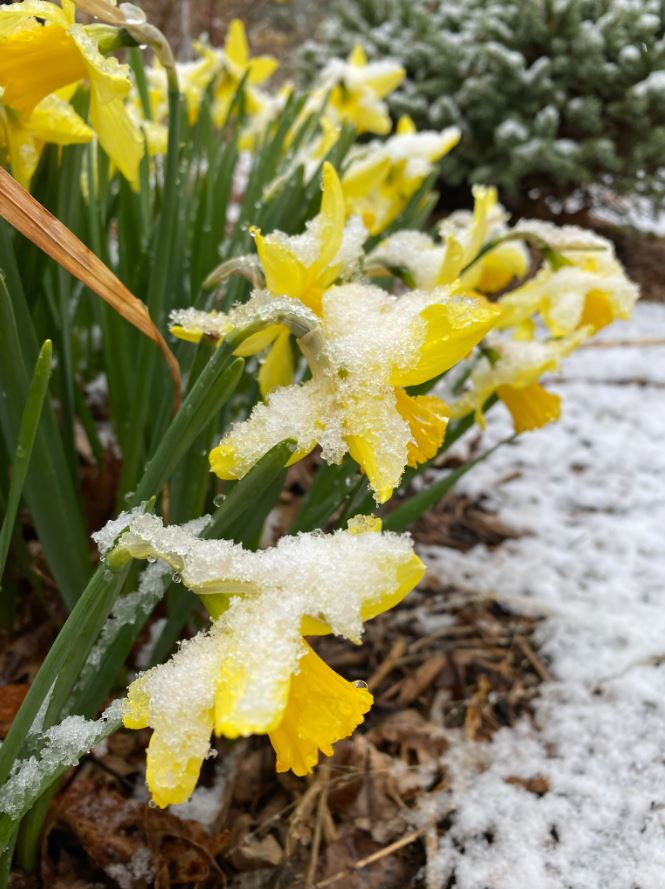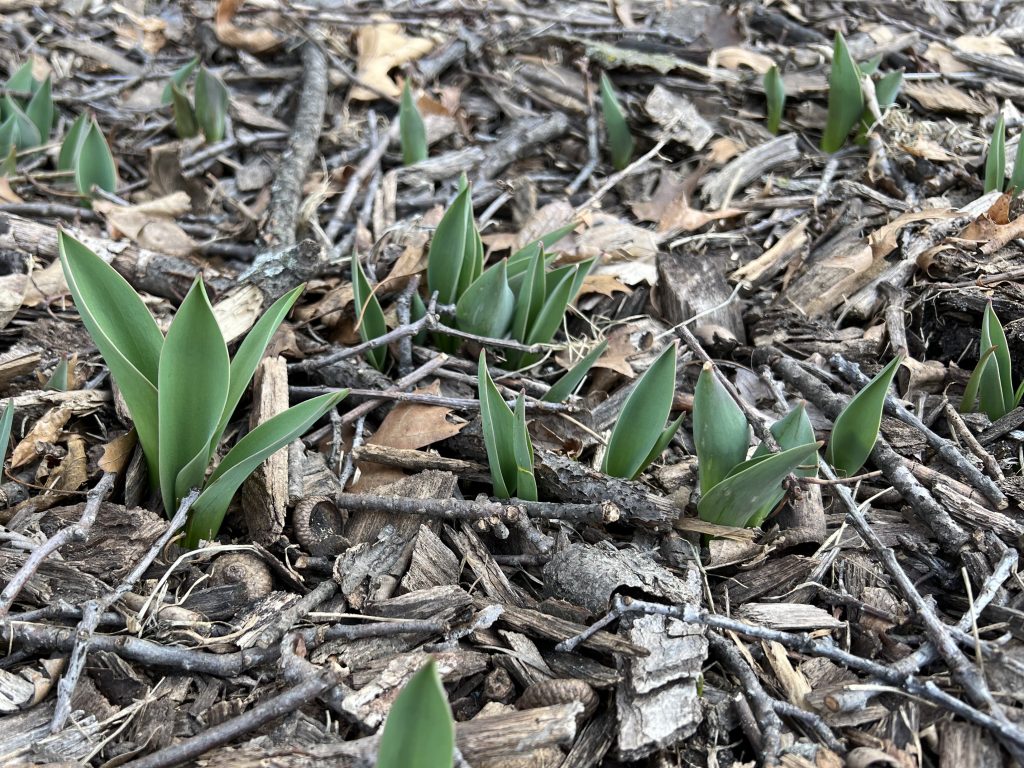How to manage garden plants that break dormancy early

A warm February is causing concern for Iowans with gardens and outdoor plants
Recent warm temperatures across Iowa have many gardeners concerned as they see buds on trees and shrubs swell and break, and foliage of perennials and spring bulbs emerge in February, much sooner than they normally would. This puts plants at higher risk of damage if below-freezing temperatures return in March or April. In this article, horticulturists with Iowa State University Extension and Outreach advise on what to do in your garden when plants break dormancy earlier than expected.
What causes plants to break dormancy early?

Garden plants enter dormancy in the fall in response to day length and temperature. As temperatures cool and nights get longer, hormones within the plant change, causing plants to gradually acclimate to cold winter temperatures and go dormant. Plants will remain dormant until specific temperature requirements (measured using “chilling hours” and “degree days”) are met. This relatively complicated and not yet fully understood system helps prevent plants from coming out of dormancy too early during a mid-winter warm-up.
Each plant species has its own chilling requirement that must be met before it will break dormancy. A mild winter can allow plants to meet their dormancy requirements earlier than usual. This makes them more likely to break bud sooner when abnormally warm temperatures occur in February or March, leading to a higher likelihood that they will experience cold damage.
What will happen to spring bulbs that emerge too early in the season?

Tulips, daffodils and other spring-flowering bulbs typically begin emerging from the ground early in the growing season. Mild winter weather can encourage even earlier emergence of these plants. This early emergence is most often seen in areas that are warmer than the rest of the yard, such as on the south and west sides of homes.
While premature emergence of foliage is undesirable, the danger is not as great as it may seem. The foliage of spring bulbs can tolerate cold temperatures. If below-freezing temperatures return after the foliage emerges, no extra protection is typically needed. Cold temperatures will delay growth and leaves usually have little to no damage. If leaves are damaged, it is often no more than a few brown tips and leaf edges, which is unsightly but not a problem for overall plant health. A blanket of snow is especially helpful in protecting leaves from extreme cold.
If the flower buds emerge early, they can be damaged or destroyed if temperatures are colder than the low 20s Fahrenheit. A layer of organic mulch, such as straw or pine needles, can be applied around the base of the emerging plants to help protect flower buds and slow further growth by insulating the soil and regulating temperature fluctuations. Remove the mulch once normal temperatures return.
What can I do to help perennials that are emerging too early?
When below-freezing temperatures occur after a warm winter period, the extent of plant damage depends on temperature, plant species, exposure and stage of plant growth. Many perennials will see little to no damage to foliage, especially early-emerging, cold-tolerant perennials such as bleeding heart, daylily, catmint and columbine. If temperatures get too cold, damage may occur, causing leaf tips, edges or entire leaves to turn white, brown and/or collapse.
If temperatures are predicted to drop into the mid-20s or teens, perennials can be protected with a layer of organic mulch, such as wood mulch, straw or pine needles, spread several inches thick. Mulch will help insulate the soil, regulate temperature fluctuations, slow growth and prevent frost heaving. Watering if the soil is dry and unfrozen will also be beneficial.
Most well-established perennials damaged by freezing temperatures should survive with no long-term damage. Plants with light damage will continue to grow, and the damage will be masked or can be trimmed out. The roots and crowns of severely damaged perennials will send up a second flush of growth, but plants will be smaller than usual this summer. Good care this spring and summer (for example, watering weekly during dry weather) should help plants recover.
How can I prevent damage to trees and shrubs that break dormancy too early?
There are no practical or effective efforts home gardeners can take to prevent freeze damage to early emerging flowers or foliage on woody plants. It is impossible to prevent plants from “waking up” too early. Flower buds that begin to swell or flowers that emerge earlier than normal due to unseasonably warm temperatures may be disfigured or destroyed when cold temperatures return. This is particularly true for early flowering species like magnolia, forsythia, rhododendrons and azaleas.
Foliage that emerges early is also susceptible to freeze damage. Symptoms include shriveling and browning or blackening of leaf tissue. Damaged growth often becomes limp and eventually drops from the tree or shrub. Damage appears to be more severe on species such as Japanese maple, hackberry, ginkgo, hydrangea, oaks and black locust.
Thankfully, below-freezing temperatures will have no long-term damage to the overall health of a healthy tree or shrub. The loss of flowers for the season is unfortunate, but provided the weather is not abnormal again, blooms can be enjoyed next year. Trees and shrubs can leaf out again if the initial growth is damaged or destroyed, and new growth will emerge later in the spring when normal temperatures return. Good care during the remainder of the year, such as watering during dry periods, should aid the recovery of woody plants planted within the past three to five years. Fertilizer is not recommended to aid in recovery from cold damage.
How will abnormally warm temperatures in February and March affect my fruit trees?
Unseasonably warm temperatures early in the growing season can cause premature bud swelling, flowering or leaf emergence in fruit trees, especially apricots and peaches, which bloom earlier than apples, pears and tart cherries. As flower buds swell, they become increasingly vulnerable to cold temperatures. They are most susceptible just before, during and after bloom.
If freezing temperatures return after a warm winter period, the amount of damage depends on the amount of premature growth. The colder the temperature and the further developed the buds and blooms are, the more likely they will be damaged or destroyed. If flowers are damaged, this year’s fruit crop may be smaller than usual. However, the trees themselves should not be seriously harmed. There are no practical efforts home gardeners can take to prevent freeze damage. (Commercial fruit growers may use wind turbines or spray water to prevent frost damage, but these efforts are not practical for home gardeners.)
While the loss of most of the fruit crop for the year is disappointing, good care during the remainder of the year will help trees recover and potentially produce a bountiful harvest the following growing season.
Can I still prune?
In a year with more typical weather conditions, February and early March (late dormant season) is an ideal time to prune. Even with warm temperatures, plants can still be pruned until bud break. However, as trees and shrubs show signs of breaking dormancy, such as swollen buds, emerging foliage, or flowering, pruning should be delayed until new growth has fully expanded (mid- to late-May). Late spring/summer pruning is perfectly acceptable in all cases except for oaks, which should only be pruned during the dormant season.
In rare cases, late cold snaps can damage branch tips. Dead branches can be removed once they are noticed, but be sure they are dead (i.e., dry and brittle) before making any pruning decisions.



